'It's a barrier dividing us': How a concrete seawall split this Japanese island village
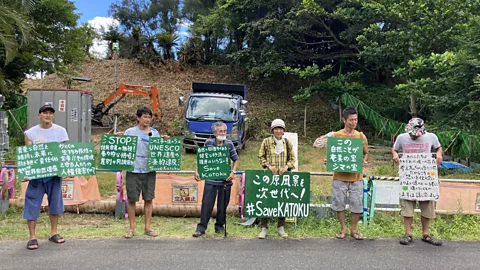 katoku.org
katoku.orgSome locals and ecologists are troubled by the potential impacts a looming seawall could have on the biodiverse Japanese island of Amami Ōshima. So is there another way to protect its beach?
Rising before dawn on an early summer day in July 2022, Hisami Take took a walk along Katoku beach in Amami Ōshima, an island nestled in the far south of Japan. Looking along the beach, she saw an animal track on the sand stretching from the ocean, then U-turning back into the water.
The track, she says, likely belonged to an endangered loggerhead sea turtle that is known to come ashore to lay eggs. "This year, no eggs were found. Maybe the shiny orange construction rope is signalling the turtles to turn away."
Take, a 49-year-old Amami resident, and many other locals on the island fear that an enormous concrete seawall about to be constructed on the beach in place of the rope could make such tracks more common by blocking endangered species like the turtle from coming to the beach.
The construction firm did not respond to a request for comment. The local authority, Kagoshima Prefecture, responded to say that construction work was proceeding with consideration for the natural environment, and would not be carried out in the coastal area during the turtles' egg-laying season. It noted it had not been confirmed that the ropes on the beach affected turtle behaviour.
Opinion on the years-long development has split the local community. Scientists and many locals worry the seawall could immovably obstruct the already threatened wildlife of the biodiverse island and argue that natural solutions such as planting local species would provide better protection from coastal erosion. Advocates of the seawall, meanwhile, say it's necessary to give both people and local land vital protection from coastal erosion and typhoons, with some seeing it as welcome infrastructure development.
It's a debate that goes to the heart of how coastal communities will respond to rising seas and more intense storms due to climate change. Hard coastal protection measures like concrete seawalls have been implemented in some areas of the world for decades, but many scientists now favour natural defences, which aim to improve local ecosystems to bolster resilience. When the two are in competition, which wins out?
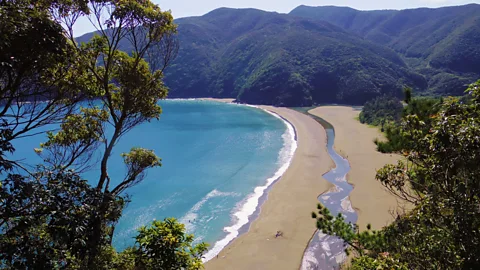 katoku.org
katoku.orgWith its white beaches and beautiful coral reefs, Amami Ōshima is widely known for its candid natural beauty. While it makes up only 0.5% of Japan's land, much of it is a biodiversity hotspot: it is home to 95 globally endangered species, 75 of them endemic, and over 1,800 species of plants. In July 2021, a part of Amami Oshima, together with sites on three neighbouring islands, was registered as a Unesco World Heritage Site for its outstanding ecological significance.
Amami retains many of its rich forests and mangroves, but Katoku is its last coastal village without concrete defences and with a free-flowing river. The area is home to endangered species such as the leatherback turtle, which has lived since before the dinosaur extinction, and the Amami rabbit, an ancient species sometimes referred to as a "living fossil".
"I could not believe a place like this existed in Amami – so mystical and almost divine," says Take, recalling her first visit to Katoku when she was 19. "Growing up in Amami, I never had a 'real' beach around. All the other beaches and rivers [on Amami Ōshima island] were hardened with concrete, but Katoku still has a beach, a river delta where freshwater flows freely from the Katoku mountains and a dynamic sand dune."
Now, though, an enormous seawall is being constructed at the beach by Kagoshima Prefecture. It says it is building the wall, which will be 180m (590ft) long and 6.5m (21ft) high, "for the safety and security of lives and assets of residents from coastal erosion caused by natural disasters such as typhoons".
The decision to build the seawall was taken in response to concerns raised by local residents back in 2014. They submitted a request to the local Setouchi town council that governs Katoku village to take measures to prevent what they believed to be dune erosion caused by two typhoons that year. They were concerned such erosion could endanger an ancestral resting place, central to their religious tradition, which lies some 70m (230ft) above the waterline. However, they did not specifically request a seawall as the solution.
The project saw final approval by the Kagoshima Prefecture in January 2018, but in the meantime other local residents have come together to oppose the seawall, arguing it is in danger of disrupting the Katoku River, affecting the entire rare beach ecosystem. In September 2020, a petition with more than 30,000 signatures was submitted to the governor of Kagoshima, mayor of Setouchi town and Setouchi town council, urging for construction to be reconsidered. Scientists, environmental groups and residents say they have also submitted appeals to the Kagoshima Prefecture to reconsider the construction and hold open discussions with residents. Several told the BBC they did not receive a response.
The Kagoshima Prefecture said it was working to post information on its website to improve public understanding of its approach. It added that the Setouchi Office did provide a verbal response to petitioners, explaining that the project was started in response to requests from Setouchi Town and local villages for its early completion. It said that the decision to build a seawall and plant pandanus trees was reached after many discussions among a committee composed of experts in coastal, aquatic organisms and the environment, as well as local residents. The prefecture said it "decided to proceed with the development in order to protect the lives and property of local residents".
Meanwhile, in 2021, the International Union for Conservation of Nature (IUCN), the official advisor on nature under the World Heritage Convention, designated the local Katoku River and neighbouring beach areas as a buffer zone. The designation means these areas are legally protected by the Japanese government.
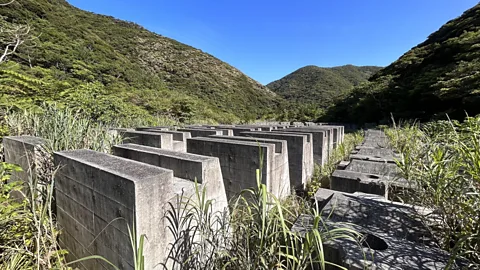 Kaori Kohyama
Kaori KohyamaThe IUCN noted the seawall construction would continue, but its report included a statement from the Japanese government saying the seawall would be "far from the mouth of the Katoku River" to avoid any negative impacts on the river. Environmental monitoring would be continued after construction to watch for any unexpected impacts too, it said.
Construction started the following year, in February 2022, but locals say it appears to have been halted several times since, as well as disrupted by sit-ins by local protestors. It restarted again in July 2024 and is now in the final stages of building a road to allow work to start on the seawall. Even as construction was underway, though, a legal case in opposition to the seawall was ongoing at the Japanese Supreme Court.
Filed in 2018, the plaintiffs consisted of locals and the Japan Environmental Lawyers Federation (Jelf), who argued that Kagoshima Prefecture is misusing public funds by pushing ahead with the project. They contended the wall is unnecessary and will not help with any sand dune erosion if indeed there is any. Kagoshima Prefecture contested the allegations, arguing that the construction is necessary to protect the village from coastal erosion caused due to natural disasters such as typhoons, and asserting that the project follows proper procedures and legal standards. The prefecture added that it was continuing to work with the IUCN through various legal and other procedures.
However, the case was dismissed by the court on 23 May 2025.
Shifting sands
Separately, some are concerned that the seawall is being built in a more problematic location than environmental overviews of the project first indicated – closer to the river mouth, risking its ecosystem and biodiversity.
After a request from the Jelf lawyers and NGO Save Katoku, Coastal Engineering Laboratory, an independent research team based in Tokyo, investigated the concerns around the impact of the seawall on the local ecosystem. In a September 2024 letter sent to Save Katoku and its defending lawyers and seen by the BBC, it concluded that the seawall is indeed set to be constructed "within" the river channel of the Katoku River. Coastal Engineering Laboratory told the BBC that it has not received any financial assistance from any of the parties involved in the legal case.
Kagoshima Prefecture noted that "depending on the season, sea sand may block the estuary due to the influence of waves, and at that time, water that has nowhere to go may meander and flow along the beach". It said that the seawall was planned in the position where the original sand dunes used to be, away from the meandering flow of water along the beach front, and not obstructing it.
"At some points of the year, the river's mouth – the entire beach – shifts seasonally, which means that the river can flow across the sand and reach right where the seawall is planned, for about six months," says Jean-Marc Takaki, head of the local non-profit Save Katoku says. "This contradicts the government's own promise of building the wall far away… among many things it disrupts the natural meandering of the river and the whole sand process of the beach essential to maintaining the ecosystem."
A spokesperson from the Kyushu bureau of Japan's Ministry of Land, Infrastructure and Transport and Tourism told the BBC that the planned seawall at Katoku Beach “will be built not on the beach but at the location of the original sand dune and is positioned away from the meandering water” and thus “will not obstruct either the meandering water flow or the natural movement of sand along the coast”.
“Furthermore, prior to the World Natural Heritage inscription, we were informed by the Ministry of the Environment that explanations were given to IUCN regarding the necessity of the seawall for disaster prevention and considerations for the natural environment, and that the inscription was granted based on that understanding," the spokesperson added.
Takaki is calling for an Unesco Reactive Monitoring mission to investigate these concerns and provide recommendations to ensure the protection and conservation of the river.
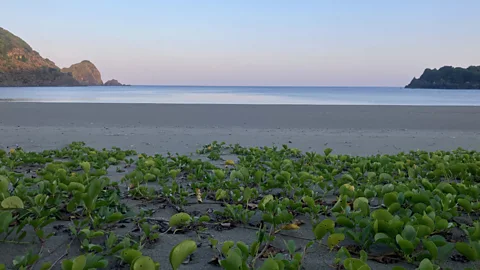 katoku.org
katoku.orgLocals also express concern about their lack of involvement in the decision-making process of the seawall. The Kagoshima Prefecture conducted surveys, including environmental studies, and three rounds of expert meetings from 2016-18, but Takaaki Kagohashi, a lawyer and longtime member of Jelf who was involved in the court case, says local residents were not consulted, except for the then-village-chief.
Kagoshima Prefecture underlined that its review committee of experts and local people is held in an open format and views are widely solicited on its website.
Shigeo Sakae, the current village chief of Katoku since April 2023, was not aware of the details of the seawall project. "I was asked by the prefecture if I support a construction that protects the residents, so I said yes," he says. Katoku, he adds, is the only village on the island that has not yet built any hard coastal structures until this seawall project. "All other villages have already completed their construction, but we are the only ones who haven't had anything done for us."
Kamata Naruhito, the mayor of Setouchi town, says projects like the seawall are needed to revitalise the economy. "Amami Oshima island has been recognised as a natural heritage site, so it is something very important that we must cherish and pass on to the next generation," he says. "However, alongside that… public works projects are also necessary with the support of the central government."
The cost of concrete
With intensifying typhoons and rising sea levels around the world, the tensions over the Katoku beach seawall will not be the last debate to emerge over the best way to protect local communities from flooding and coastal erosion.
Seawalls have long been considered a primary solution for coastal protection, particularly against storm surges and erosion. Hard coastal protection measures such as dikes, embankments, seawalls and surge barriers are now widespread, providing predictable levels of safety in many coastal cities and deltas around the world, according to a 2019 report from the Intergovernmental Panel on Climate Change (IPCC).
More like this:
• Where EV batteries go to die – and be reborn
• What we've learned about cleaning up major oil spills since Deepwater Horizon
• The cement that could turn your house into a giant battery
But these measures can come with a heavy cost both economically and environmentally, says Satoko Seino, associate professor at the department of ecological engineering at Kyushu University, Japan, who studies coastal seafloors.
"Concrete seawalls not only demand heavy investment but also incur ongoing maintenance costs," says Seino. Kominato beach, which lies next to Katoku on Amami Ōshima, once shared a similar landscape with a pristine sand beach supporting both human and wildlife. With construction projects including renovation and reconstruction of breakwaters, embankments, wharves, boat ramps, roads and land development totalling some 5.32 billion yen (£27m/ $34m) since the 1970s, parts of Kominato beach are now littered with neglected concrete.
Edward Atkin, director of eCoast Marine Consulting and Research in New Zealand, has studied Kominato beach and compared it with Katoku. In a 2021 assessment, he concluded that the Kominato seawalls exacerbated erosion and shortened the beach width, while the seawall itself has also been eroded by sea water. He noted that both Kominato and Katoku beaches had the same "pocket beach" structure, where the beach holds a closed off and highly sensitive sand system that moves around under different wave conditions.
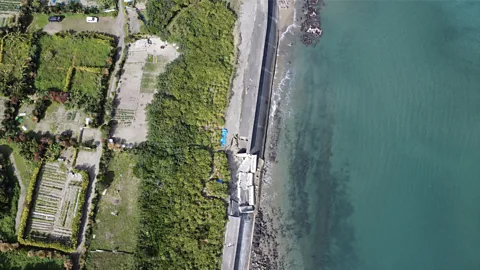 katoku.org
katoku.orgSince around the 2000s, and especially in Europe and North America, there has been a shift in coastal management towards the use of eco-engineering and nature-based solutions – ways of working with natural ecosystems to address environmental challenges, says Seino. "These approaches integrate natural systems which not only protect against storm surges but also preserve biodiversity," she says.
In areas where natural ecosystems like dunes and mangroves offer protection, experts frequently recommend nature-based solutions as more sustainable options, according to the IPCC. This chimes with research which shows that nature-focused solutions to societal challenges more widely often provide economic and social benefits.
In the US, the National Oceanic and Atmospheric Administration (Noaa) has similarly encouraged the use of "living shorelines", an approach that uses "green infrastructure" such as plants and sand rather than concrete or rock to defend coastlines. Research has shown this method is effective at protecting against erosion and storm surges and can even be more resilient than bulkheads in protecting against the effects of hurricanes, while also providing other benefits such as soaking up nutrient pollution and supporting fish habitat.
Amendments to Japan's Seacoast Law in 1999 aimed to implement more sustainable coastal management and conservation plans, but progress has been slow, says Seino. "Once people see concrete hardening as the answer, it's difficult to change that mindset." The BBC contacted Japan's Ministry of the Environment but received no comment.
Since 2018, Japan's environment ministry has also been promoting an ecosystem-based disaster risk reduction (Eco-DRR) initiative, an approach to disaster prevention which aims to also build a sustainable, safe and affluent society living in harmony with nature. In a letter to the IUCN on 8 November 2019, the Japanese government said an "eco-friendly" seawall would be built at Katoku beach, covering concrete embankments with sand and plants, presenting the project as a nature-friendly Eco-DRR initiative.
"Nice try, but it doesn't work like that," says Wesley Crile, a coastal dune restoration specialist at the University of Hawaii who has led on multiple community-based dune restoration projects on Maui Island in Hawaii.
Maui Island has a similar sand dune system and vegetation, including pandanus trees and morning glories, to Katoku. Crile highlights how the community uses natural processes instead of concrete structures to prevent coastal erosion.
"For example, morning glories, which are present both in Maui and Amami, can trap wind-blown sand with their cup-shaped leaves, gradually building up dunes," Crile says. If a storm takes some sand from the dune, the dune shape will be affected on the surface, he adds. "But when the storm subsides, the sand process will restart and the dune can be rebuilt with time." Japan's Ministry of the Environment did not respond to the BBC's request for comment.
Seino's coastal seafloor studies have similarly led her to support a natural dune restoration process at Katoku. Healthy beaches have a "natural ability" to recover, even if they are temporarily eroded, she says.
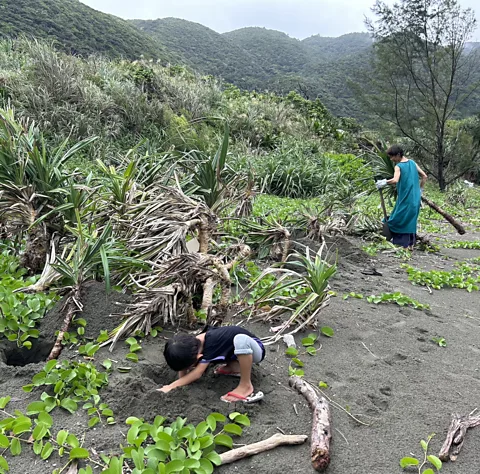 Kaori Kohyama
Kaori Kohyama"It's like when a person falls and gets a scrape or a bruise – while it may look serious on the surface, their overall vitality isn't compromised," she says. "Similarly, such a coastline remains resilient. Even if the surface layer of sand is completely stripped away, it will eventually come back. As long as the dune is in a healthy state, it will function as a natural seawall, basically.
In Katoku, planting projects led by volunteers and locals have taken place several times since 2015, before the seawall was approved. Planting of pandanus trees and morning glories – both also indigenous to Amami – mirrors the restoration initiatives in Hawaii that utilise the inherent regenerative power of coastal dunes.
"The area in front of the cemetery is now flourishing with tall pandanus trees, and the once-severe erosion has disappeared," says 90-year-old Hiroaki Sono, who has lived on the island for most of his life and leads the non-profit Environmental Network Amami. However, he adds, the long-term sand movements and characteristics of the beach should be studied "more closely" before any decision is made on how best to protect the habitat. Kagoshima Prefecture did not respond to the BBC's request for comment.
Local collaboration is a crucial part of implementing nature-based solutions, adds Naoshi Nagae, a conservationist and the head of the local Amami Nature School, who focuses on environmental education by leveraging the knowledge of locals. For example, as pandanus trees take time to grow, it is better to use transplants of young trees rather than seeds, he says. "Ideally, these trees should come from the same village, or at least a neighbouring one, to avoid invasive species."
Carbon Count
The emissions from travel it took to report this story were an estimated 170kg CO2. The digital emissions from this story are an estimated 1.2g to 3.6g CO2 per page view. Find out more about how we calculated this figure here.
The debate over the two proposed solutions to save Katoku Beach – building the seawall or restoring the natural sand dune through planting of local species – has sparked an ongoing conflict among the community at Amami. "This seawall controversy is not just about nature and people's lives, it's a barrier dividing us," says Takaki.
Eriko Minayoshi, a traditional folk singer, has been part of a long-running sit-in protest against the construction. "At the site, no one is offering any real explanation," she says. "All they say is, 'You are blocking business, get out of the way.' Every day feels like an emotional weight. Even in my sleep, I am haunted by images of construction." She has also begun to feel the toll of the protest on her body, she says. The construction firm did not respond to the BBC's request for comment.
Take believes that an open dialogue between the residents and the authorities is essential to finding solutions. "Deep down, I know that everyone shares the same wish to protect the beach," she says. "We need to work together to discuss and find what is truly best for everyone, for our Katoku beach."
--
*This story was updated on 23 May 2025 to include responses from Kagoshima Prefecture received after initial publication on 13 May 2025. It was again updated on 30 May 2025 to include responses from Japan's Ministry of Land, Infrastructure and Transport and Tourism received after initial publication, and to note the dismissal of the legal case by the Supreme Court of Japan.
For essential climate news and hopeful developments to your inbox, sign up to the Future Earth newsletter, while The Essential List delivers a handpicked selection of features and insights twice a week.
